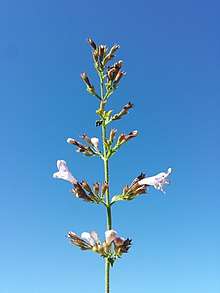Clinopodium menthifolium
Clinopodium menthifolium, commonly known as the wood calamint or woodland calamint, is a species of flowering plant in the family Lamiaceae. It is found throughout southern and central Europe from the United Kingdom and east as far as temperate parts of Asia, and as south as North Africa. It grows up to 1700m in elevation.[1]
| Clinopodium menthifolium | |
|---|---|
 | |
| Scientific classification | |
| Kingdom: | Plantae |
| Clade: | Tracheophytes |
| Clade: | Angiosperms |
| Clade: | Eudicots |
| Clade: | Asterids |
| Order: | Lamiales |
| Family: | Lamiaceae |
| Genus: | Clinopodium |
| Species: | C. menthifolium |
| Binomial name | |
| Clinopodium menthifolium (Host) Stace, 1989 | |
| Synonyms | |
| |
Subspecies
- Clinopodium menthifolium subsp. ascendens (Jord.) Govaerts (1999)
- Clinopodium menthifolium subsp. hirtum (Briq.) Govaerts (1999)
- Clinopodium menthifolium subsp. menthifolium
gollark: Yes, and I'm saying it should be used more.
gollark: Even static typing is an example of detecting and stopping some classes of mistake.
gollark: PERFECT issue detection would be, PARTIAL stuff already exists.
gollark: I mean, when someone finds out about an exploit and it's known about, you can fix it. The legal system getting involved probably won't help there. You need issues to be detected in a testing phase or ideally during compilation.
gollark: Clever!
References
This article is issued from Wikipedia. The text is licensed under Creative Commons - Attribution - Sharealike. Additional terms may apply for the media files.